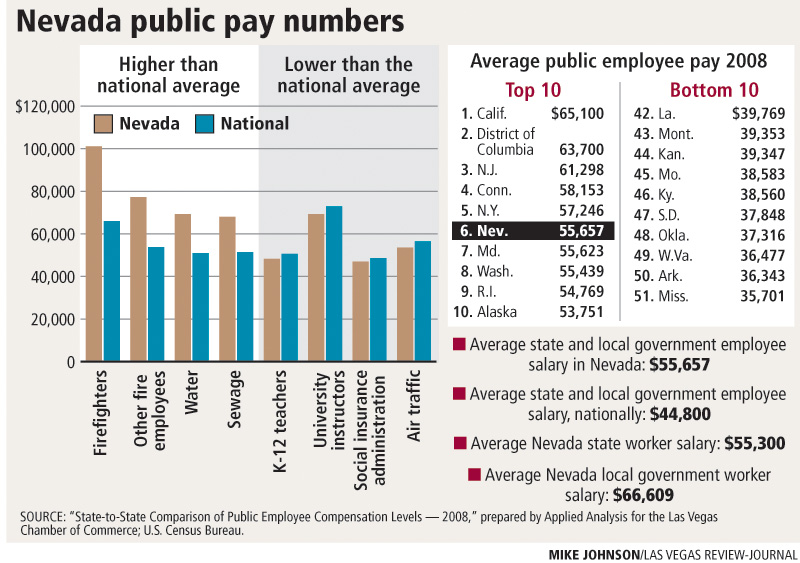Nevada ranks sixth in public pay
Nevada's state and local government employees made an average salary of $55,657 in 2008, moving them to sixth highest in the nation, according to a study released Wednesday.
That is above the national average, $48,800, for state and local public workers. Nevada also moved up in the rankings from 2006, when the state was in eighth place nationally.
The study was done for the Las Vegas Chamber of Commerce and is an update to one done two years ago, which the chamber also commissioned.
It uses data compiled by the U.S. Census Bureau for 2008, the latest year for which the information is available.
While the study produces a figure for all Nevada public workers, it notes that a large gap exists between what state workers and local government workers make. Also, K-12 teachers, the largest single group, make less than the national average, as do university instructors here.
Nevada also has the leanest government in the United States, according to the study, which doesn't take into account cutbacks made in 2009 in response to the economic downturn. The cuts included furloughs for state workers and some labor contract changes aimed at controlling the rate of salary growth.
The study "tells us that Nevada state and local government are relatively small," said Jeremy Aguero of Applied Analysis, which did the study for the chamber. "It also tells us that we have among the highest paid, which in one way makes sense because there's fewer of them."
But when state and local governments are staring at budget deficits, the comparisons need to be made.
"It asks a very serious question as we deal with these financial difficulties, and that is: Why is it that it costs us so much more to provide these services in Nevada than in other parts of the country?" Aguero said.
Dennis Mallory of the American Federation of State, County and Municipal Employees, which represents state workers, said the study did more than point out the relatively higher salaries of Nevada's public sector.
"It still shows the ratio (of government employees) was the lowest ratio in all 50 states, which I think says a lot for how hard our folks work," he said. "It's certainly indicative of the fact that we can't afford any more furloughs because that ratio is only going to go up, nor can we afford any layoffs.
"I think the taxpayers of the state of Nevada get a lot of bang for their buck."
That's true, said Steve Hill, chairman of the chamber committee that studies the issue. The problem, in the chamber's view, is that the number of bucks being shelled out is "unsustainable."
"It's just, 'Hey, these pay levels are exceptionally high at this point, and over time we're going to have to do something about this,'" Hill said. "There's no question that we should not have allowed ourselves to get into this situation. Taking anything away from anyone that you've given to them is painful.
"We have to make a choice here. The alternative is, we're going to take 8 percent of the folks that we need ... and say, 'Guess what? You don't get to have your job anymore.' The choice that our local governments are faced with is just that."
There are significant differences between local government employees and state workers, Hill and the study noted.
State workers cannot collectively bargain and usually participate more in their benefit costs. Many local government employees are union members who have binding labor contracts with their respective governmental entities.
There is a marked difference in average salary between state and local workers, Aguero noted. The average pay for a state worker in Nevada was $55,266. For a local government employee, the average was $66,609.
The jobs that ranked furthest above the national average were firefighters, other fire employees, and water and sewage workers.
Four classifications in Nevada made less than the national average: K-12 and university instructors, air transportation workers and social insurance administrators, who work in unemployment compensation systems, public employment services, and the Federal Social Security, Medicare, and Railroad Retirement trusts.
The study also looked at the ratio of public employees to residents, and in that category Nevada had the lowest number with 43.7 workers per 1,000 residents. The last study had the same finding, showing that in 2006, Nevada had 41.4 employees per 1,000 residents. "No state had a smaller government work force in either year," the report said.
Las Vegas Chamber of Commerce report

















